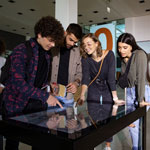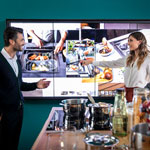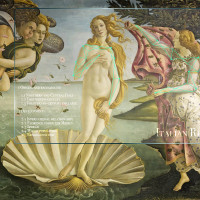
CULTURAL HERITAGE
Culture heritage becomes an experience
Solutions to attract visitors, entertain them and inform them through digital engagement.

Dallara, an international point of reference in the field of racecars since 1972, asked us to take part in the Dallara Academy project: the creation of a center for excellence in technical training specialized in the automotive field. The Academy is in the heart of the Emilia motor valley, Varano de’ Melegari.
To use the words of the engineer who is the President and founder, Mr. Giampaolo Dallara, "My intention and the aim of this Academy are to thank, by exhibiting our most significant cars, all the collaborators who have contributed to the company's reputation and growth. There is also a willingness to work with the Universities of MUNER for the training of tomorrow's engineers. But above all there is the desire to create a meeting place, a center of stimuli and interests that is truly alive and open for our valley and the community."
The Dallara Academy was strongly desired by Mr. Giampaolo Dallara, and designed by the Genoese architect Alfonso Femia, Atelier(s) Alfonso Femia. The building is devoid of fences and barriers and blends in perfectly with its surroundings. It is spread over two main levels, connected by a spectacular curved ramp with windows.
"A building that keeps in mind the surrounding topography, its inclusion in the landscape, its double perception (from the outside and the inside) and which has the will to be a space for research, design, meetings, and excellence,“ said architect Alfonso Femia, "a building that is fast and slow, silent and resonant, technological and poetic."
We at Touchwindow were involved since the early stages of design, with the aim of creating a unique experience and putting in place all the best technology available on the market today.
The design and consulting phases allowed us to develop a series of ideas and to interact with the best technological partners on the global stage. We had direct contact with architects, construction management, plant engineers, builders, workers, but also marketing and communications. We were able to take part in the rationale of the project and its objectives, putting us in a position to tackle the significant design challenges.
During the design phase we devised solutions that allow all of the different souls of the building to be functional and connected, creating a unique and exciting Digital Environment. Dallara Academy is in fact both an advanced training laboratory, a museum and a large auditorium, rationally located in a bold but perfectly functional architectural structure.
The ground floor is dedicated to hosting visitors and educational workshops for students of middle schools and high schools. Dallara Academy experiments with innovative teaching in these spaces, combining education and entertainment thanks to technological innovation.
On the first floor there is the area for university education, where 150 university students (of which 30 from abroad) are in their second year and about to receive a Master's degree in Racing Car Design from MUNER, Motorvehicle University of Emilia Romagna. This university is supported by the motor valley companies, the Emilia Romagna Region and the universities of Bologna, Parma, Modena-Reggio Emilia and Ferrara. A modern auditorium is located next to the classrooms.
The ramp houses historic cars created by the Mr. Dallara and his company, from the famous Miura to the X19, from racing cars to road cars. They are in a building that seems to be having a happy discourse with the surrounding territory, thanks to the large and bright windows.
Our team of engineers and technicians immediately concentrated on studying and designing the communications architecture between the different spaces. The first step was the design of the network infrastructure so the three main racks could communicate. Within those we integrated all of the technological devices for the control and management of the video and audio devices installed in the various rooms. The infrastructure completely controls all of the devices through an easy-to-use software.
The next step was the definition of the most advanced technological devices that would equip every space, and we planned, with care and precision, every phase of the implementation of the integrated systems.
During the operational stage we installed network systems and signal distribution technologies, using fiber optic cables and high-performance switches. Working shoulder-to-shoulder with installers and construction management, we were able to effectively integrate our system into the very modern interiors of the Academy and create audio-video communication between them.
We were also responsible for the display structures of all the visual devices, such as the large LED wall on the exhibition ramp and the Multifunction room, as well as the large format displays and the loudspeakers. In particular, for the large Auditorium, capable of hosting up to 350 people, we created a 7x2m LED wall. Each element was carefully designed and has been installed in such a way as to be seamlessly integrated with the set-up of the various rooms.
The testing phase before inauguration day allowed us to test all of the systems to make sure that they were perfectly functioning.
The inauguration of the Dallara Academy took place on 21 September, 2018. "I have learned from many people during my life. Now it was time to try to give something back to others.” Those were the words of Giampaolo Dallara as he inaugurated the building. The event also featured an extraordinary guest, Alex Zanardi. Whilst in the presence of journalists and notable people we were able to see the Digital Environment created by us come alive, and we were proud being a part of a project that looks to the future. In the words of Mr. Dallara, "Until now we’ve had a supply chain; we are now starting to have a knowledge chain.”

Solutions to attract visitors, entertain them and inform them through digital engagement.

We create showrooms and corporate museums where you can tell your story in a new and exciting way.

Capture audience attention and engage viewers with impactful visualization systems and integrated AVL architectures.

When setting up meeting rooms and newly designed workspaces, the goal is to enhance the environment in which people operate, improving the quality of time spent in at work and fostering interpersonal relationships, both in-person and remotely.

Can digital innovation change the way we think about, manage and promote museums?

Discover our interactive and immersive solutions for the “Piano Scuola 4.0”, an important opportunity to make schools a participatory environment with engaging teaching methods and more learning opportunities for students.